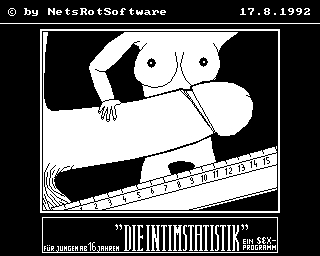- Details
- Geschrieben von Super User
- Hauptkategorie: Magazines
- Kategorie: CFOG's PIP
- Veröffentlicht: 30. November 1987
- Zugriffe: 24932
CFOG's PIP, July 1986, Volume 4 No. 9, Whole No. 45, page 11
SUTOL REPORT by DRAM, Wonderdog Companion of Lamont Cranston
[The following report was first seen in the July 1986 issue of Dogbytes, the newsletter of the Denver Osborne Group. -- bhc]
Dram, like his master Lamont Cranston, makes himself invisible and becomes Nose, defender of right and CP/M, finder of lost sectors and corrector of parity errors. He sniffs out the truth about PC hardware and software, uncovering villainous plots against the micro user. In this report Nose catches a planning setion at Sutol, providers of the infamous spreadsheet 99, 98, 97 and that well known high priced spread, Chorus ...
Voice #1:
"Well, Crayon, how's the new product coming?"
Voice #2:
"Not bad. The new array is going to be one hundred thousand cubed. We tested it by running the IRS returns for every man, woman, and child in the U.S. for 10 years and only used 10 percent of the capacity. The macros are so complex that it will take people years to learn to write them. With such an investment in time and trouble they'll never want to change to anything else, no matter how much better it might be. We have managed to incorporate many of the features of SuperKalc, but we couldn't fit them all in."
Voice #1:
"Good. How about the size of the product? Does it meet our objectives?"
Voice #2:
"And then some. The code itself is only 924K. But, once we put in six levels of copy protection, four particularly irritating stops and commercials and add filler for future product degredation, add delay loops to slow down the processing and replace BIOS, BDOS and all the drivers with less efficient but proprietary packages it looks like twenty-one 1.2 Meg floppies. We are also planning to offer it already installed on a take home 30 Meg hard drive."
Voice #l:
"Hmm. Sounds nice. How about RAM? What will it take to run it?"
Voice #2:
"A spreadsheet to do the average American family budget should run about a gigabyte of RAM. Anything worthwhile should take about twice that."
Voice #1:
"Any problem with the other members of the Cartel?"
Voice #2:
"The guys over at SM-DOS (Sado-masochistic) were complaining that we only left them one megabyte to load their operating system, but they settled down when I pointed out that they held the lions share of the stock in Cow-chips, the new memory subsidiary."
Voice #1:
"Did the labs people run any retrograde tests to determine what it would have taken to do this on CP/M?"
Voice #2:
"Yeah. We got the usual result."
Voice #1:
"What's that?"
Voice #2:
"Looks like about 6k if we were sloppy with the code and . . . You hear a sniffing sound?"
The Shadow Nose
CFOG's PIP, July 1986, Volume 4 No. 9, Whole No. 45, page 11
Kaypro Still Makes CP/M Systems
A letter from Kaypro Corporation reminds us that there is still at least one manufacturer out there still making 'pure' CP/M 2.2 systems. Sent to subscribers to Profiles, the Kaypro corporate magazine, was a letter offering a "Kaypro Jr. Business Pak", consisting of a Kaypro 1 computer <2 DSDD floppy drives, 9" green screen, etc.>, a Kaypro daisy wheel printer, WordStar, Type-It, and CP/M 2.2. Aimed at parents of college students, a discount coupon was enclosed with the letter.
CFOG's PIP, July 1986, Volume 4 No. 9, Whole No. 45, page 11
PC Pursuit Command Set
[The following appeared as a message on CFOG's #2 RCPM. -- bhc]
Well, just found out a couple of things today that make PC Pursuit a lot easier to live with!
When I signed up with the service, I was given instructions on how to use the Hayes 'AT' command set to control the PC Pursuit host modem. What I wasn't told, was that apparently PC Pursuit is using Racal-Vadic modems and that they support another command set. To enter this optional mode you first enter "ATZ" to reset the modem. Next you type "E" then a carriage return. If all is successful, the modem will respond with "Hello: I'm Ready". The prompt in this mode is a "*".
There are several commands available in this mode. For a list of them, type a "?". The most useful command is "D", as in : "D6551206". Does anyone have an explanation as to why PC Pursuit doesn't tell you that "D" instead of "ATDT" may be used to dial a number?
Anyway, the progress reports in this mode are a lot more informative. You get messages such as "DIALING", "RINGING", "ANSWER TONE", "ONLINE", "NO DIAL TONE",and "BUSY". If the number you dial is busy, you are immediately returned to the command mode instead of waiting for the 30 second timeout which the Hayes mode uses.
Another useful command is the "R" for redial. If you enter "R", you are prompted for the number of times to try, you are allowed 1 - 9. After you enter a number, the last number you dialed is dialed until it answers or the number of tries you specified is reached. You may abort by pressing any key.
You may manually disconnect from your host system at any time by pressing "^C^D".
When you are finished with PC Pursuit, type an "I" at the "*" prompt to reset the modem to the 'AT' mode f or the next caller.
- << Zurück
- Weiter




